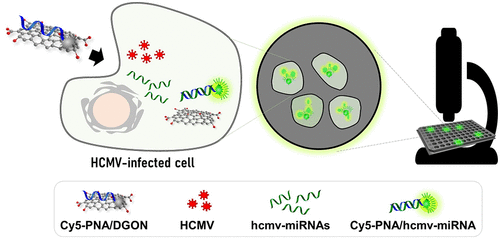Our official English website, www.x-mol.net, welcomes your feedback! (Note: you will need to create a separate account there.)
Fluorometric Viral miRNA Nanosensor for Diagnosis of Productive (Lytic) Human Cytomegalovirus Infection in Living Cells
ACS Sensors ( IF 8.9 ) Pub Date : 2021-02-02 , DOI: 10.1021/acssensors.0c01843 Ji-Seon Lee 1 , Seongchan Kim 1 , Sungchul Kim 2, 3 , Kwangseog Ahn 2, 3 , Dal-Hee Min 1, 3, 4
ACS Sensors ( IF 8.9 ) Pub Date : 2021-02-02 , DOI: 10.1021/acssensors.0c01843 Ji-Seon Lee 1 , Seongchan Kim 1 , Sungchul Kim 2, 3 , Kwangseog Ahn 2, 3 , Dal-Hee Min 1, 3, 4
Affiliation

|
A human cytomegalovirus (HCMV) causes a persistent asymptomatic infection in healthy individuals and possesses unexpected dangers to newborn babies, immunocompromised people, and organ transplant recipients because of stealth transmission. Thus, an early and accurate diagnosis of HCMV infection is crucial for prevention of unexpected transmission and progression of the severe diseases. The standard method of HCMV diagnosis depends on serology, antigen test, and polymerase chain reaction-based nucleic acid detection, which have advantages for each target molecule. However, the serological test for an antibody is an indirect method assuming the past virus infection, and antigen and viral nucleic acid testing demand laborious, complex multistep procedures for direct virus detection. Herein, we present an alternative simple and facile fluorometric biosensor composed of a graphene oxide nanocolloid and fluorescent peptide nucleic acid (PNA) probe to detect the HCMV infection by simply monitoring the virally encoded microRNA as a new biomarker of lytic virus infection. We verify the sensing of HCMV-derived microRNA accumulated within 72 h after HCMV infection and examine the diagnosis of HCMV in living cells. We proceed with the time course and concentration-dependent investigation of hcmv-miRNA sensing in living cells as a direct method of HCMV detection at the molecular level on the basis of an intracellular hcmv-miRNA expression profile and graphene oxide nanocolloid-based simple diagnostic platform. The fluorometric biosensor enables the sequence-specific binding to the target HCMV miRNAs in HCMV-infected fibroblasts and shows the quantitative detection capability of HCMV infection to be as low as 4.15 × 105 immunofluorescence focus unit (IFU)/mL of the virus titer at 48 h post-infection with picomolar sensitivity for HCMV miRNA.
中文翻译:

荧光病毒miRNA纳米传感器,用于诊断活细胞中生产性(裂解性)人巨细胞病毒感染
人类巨细胞病毒(HCMV)在健康个体中引起持续的无症状感染,并且由于隐身传播而对新生婴儿,免疫功能低下的人和器官移植接受者具有意想不到的危险。因此,HCMV感染的早期和准确诊断对于预防严重疾病的意外传播和进展至关重要。HCMV诊断的标准方法取决于血清学,抗原检测和基于聚合酶链反应的核酸检测,这对每个靶分子都有优势。然而,假定过去的病毒感染,抗体的血清学测试是一种间接方法,而抗原和病毒核酸测试则需要费力,复杂的多步骤程序来直接检测病毒。在此处,我们提出了另一种简单易用的荧光生物传感器,该传感器由氧化石墨烯纳米胶体和荧光肽核酸(PNA)探针组成,可通过简单地监测病毒编码的microRNA作为裂解性病毒感染的新生物标记物来检测HCMV感染。我们验证了HCMV感染后72小时内积累的HCMV衍生的微小RNA的感觉,并检查了活细胞中HCMV的诊断。我们基于细胞内hcmv-miRNA表达谱和基于氧化石墨烯纳米胶体的简单诊断平台,在分子水平上进行HCMV检测的直接方法,进行活细胞中hcmv-miRNA感测的时程和浓度依赖性研究。感染后48 h,对HCMV miRNA的皮摩尔灵敏度为5免疫荧光焦点单位(IFU)/ mL的病毒滴度。
更新日期:2021-03-26
中文翻译:

荧光病毒miRNA纳米传感器,用于诊断活细胞中生产性(裂解性)人巨细胞病毒感染
人类巨细胞病毒(HCMV)在健康个体中引起持续的无症状感染,并且由于隐身传播而对新生婴儿,免疫功能低下的人和器官移植接受者具有意想不到的危险。因此,HCMV感染的早期和准确诊断对于预防严重疾病的意外传播和进展至关重要。HCMV诊断的标准方法取决于血清学,抗原检测和基于聚合酶链反应的核酸检测,这对每个靶分子都有优势。然而,假定过去的病毒感染,抗体的血清学测试是一种间接方法,而抗原和病毒核酸测试则需要费力,复杂的多步骤程序来直接检测病毒。在此处,我们提出了另一种简单易用的荧光生物传感器,该传感器由氧化石墨烯纳米胶体和荧光肽核酸(PNA)探针组成,可通过简单地监测病毒编码的microRNA作为裂解性病毒感染的新生物标记物来检测HCMV感染。我们验证了HCMV感染后72小时内积累的HCMV衍生的微小RNA的感觉,并检查了活细胞中HCMV的诊断。我们基于细胞内hcmv-miRNA表达谱和基于氧化石墨烯纳米胶体的简单诊断平台,在分子水平上进行HCMV检测的直接方法,进行活细胞中hcmv-miRNA感测的时程和浓度依赖性研究。感染后48 h,对HCMV miRNA的皮摩尔灵敏度为5免疫荧光焦点单位(IFU)/ mL的病毒滴度。


























 京公网安备 11010802027423号
京公网安备 11010802027423号